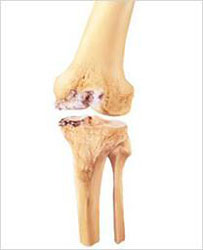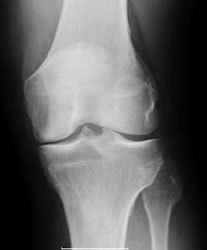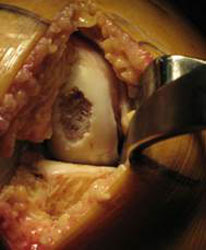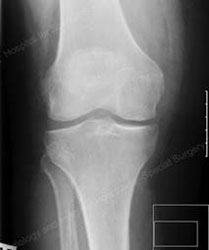Unicompartmental Knee Prosthesis as an option for the treatment of knee osteoarthritis. (Part One)
Introduction
The knee prosthesis (knee arthroplasty) has proven to be a very effective tool in the surgical treatment of knee osteoarthritis for many years. Recently, the Unicompartmental Knee Prosthesis has emerged as a possible option for some patients.
 |
 |
| Osteoarthritis of the medial compartment | |
The knee consists of three compartments: the medial compartment, the lateral compartment, and the patellofemoral compartment. In a portion of osteoarthritic patients, not always is the entire knee affected by arthritis. In some patients, only the medial compartment, or in some less common cases only the lateral compartment is affected by this disease.
In these patients, the Unicompartmental Knee Prosthesis may be considered as an option for their treatment. The term unicompartmental refers to the replacement of only one compartment of the knee, compared to the Total Knee Prosthesis that involves the replacement of all three compartments of the knee.
 |
 |
| Spontaneous osteonecrosis of the medial compartment | |
Since in Unicompartmental Prostheses only a part of the joint is replaced, the procedure is performed through a smaller incision (smaller than total prosthesis), involves less bone and soft tissue dissection, and potentially offers greater benefits in the healing phase and earlier rehabilitation.
Almost all studies show that Unicompartmental Prostheses have less blood loss during and after the procedure, as well as a lower incidence of medical complications. Patients who undergo this procedure have better results in terms of some functions such as climbing stairs or kneeling.
Many studies show that patients who have undergone a successful unicompartmental knee replacement procedure regain the range of motion of the knee faster and generally have a larger range of knee movements compared to patients who undergo a total knee prosthesis.
On the other hand, the revision rate for Unicompartmental Prostheses is higher than for Total Knee Prostheses. Also, based on the studies, the revision of a unicompartmental prosthesis does not result in the same functional outcome as a patient who undergoes a Total Prosthesis as a primary procedure. Also, technically, the revision is more complex than the Total Prosthesis as a primary procedure especially when there has been a loss of bone mass or a limited range of motion.
History of the Unicompartmental Prosthesis
At the end of the 50s and the beginning of the 60s, MacIntosh and McKeever gave the first reports on the replacement of the affected part of the tibial plateau with a prosthetic disk. The first prostheses were without cement.
In the early 70s, Gunston and Marmor independently developed and implemented the Unicompartmental Knee Prosthesis with cement.
In 1988, after a follow-up period of 10 – 13 years of 97 cases, Marmor reported 21 cases of procedural failure, blaming the progression of arthritis in other knee components or “loosening”. Install published a study where the revision rate in Total Knee Prosthesis was about 22%.
In this way, at the end of the 80s, the popularity of the Unicompartmental Knee Prosthesis decreased. However, after it was noticed that overcorrection of mechanical axes should be avoided, surgeons were able to reduce the risk of pain in the unaffected compartment leading to a quick failure of the procedure.
With the publication of various studies at the end of the 80s and the beginning of the 90s, where after a 10-year follow-up the success of survival exceeded 93%, enthusiasm for the Unicompartmental Prosthesis began to increase again because the survival rates of this procedure were comparable to those of the Total Knee Prosthesis.
In recent years, there has been a significant increase in interest for the Unicompartmental Prosthesis, also because of the introduction of the minimally invasive prepatellar technique. This procedure potentially could reduce morbidity, complications, and prolonged hospital stays.